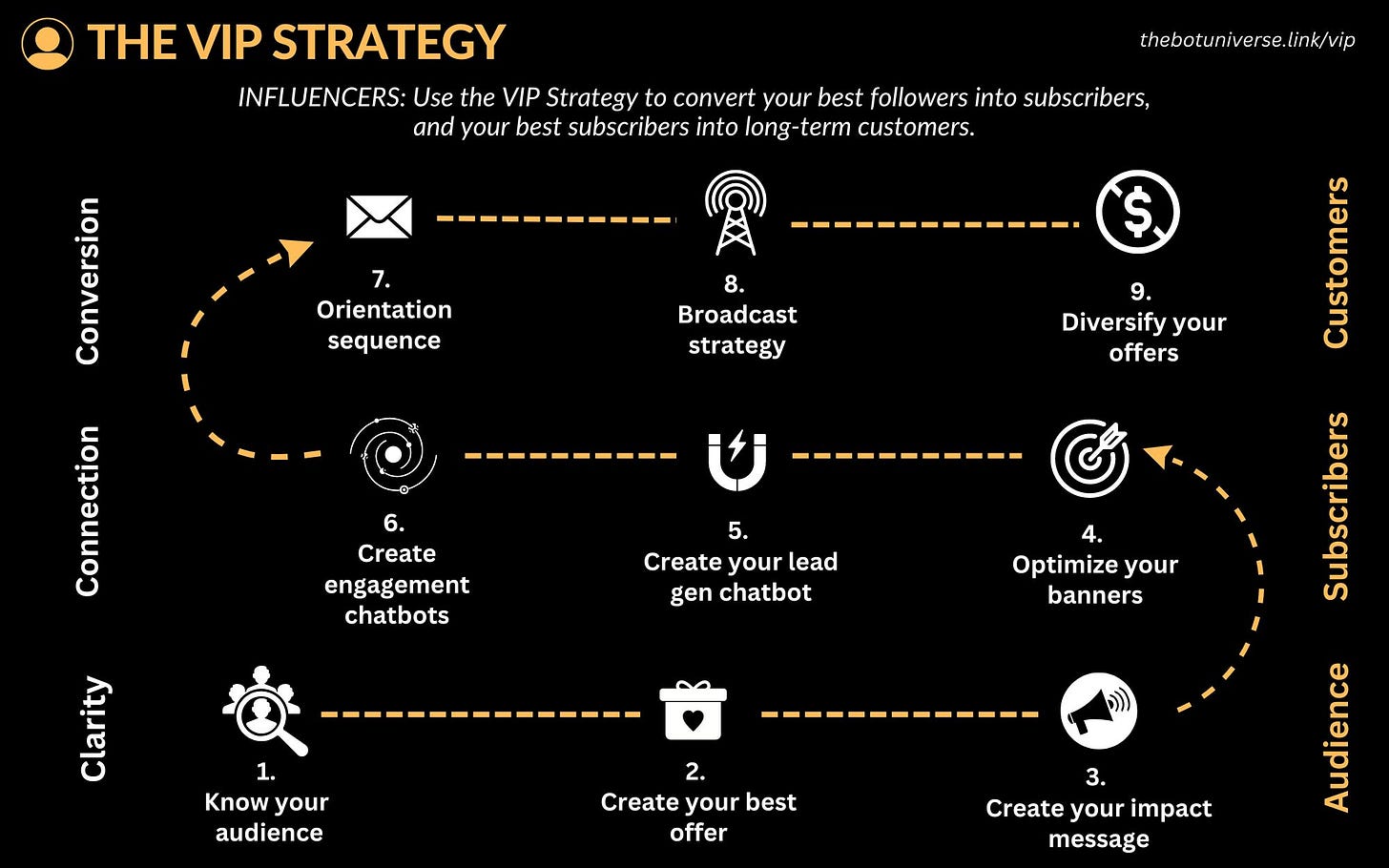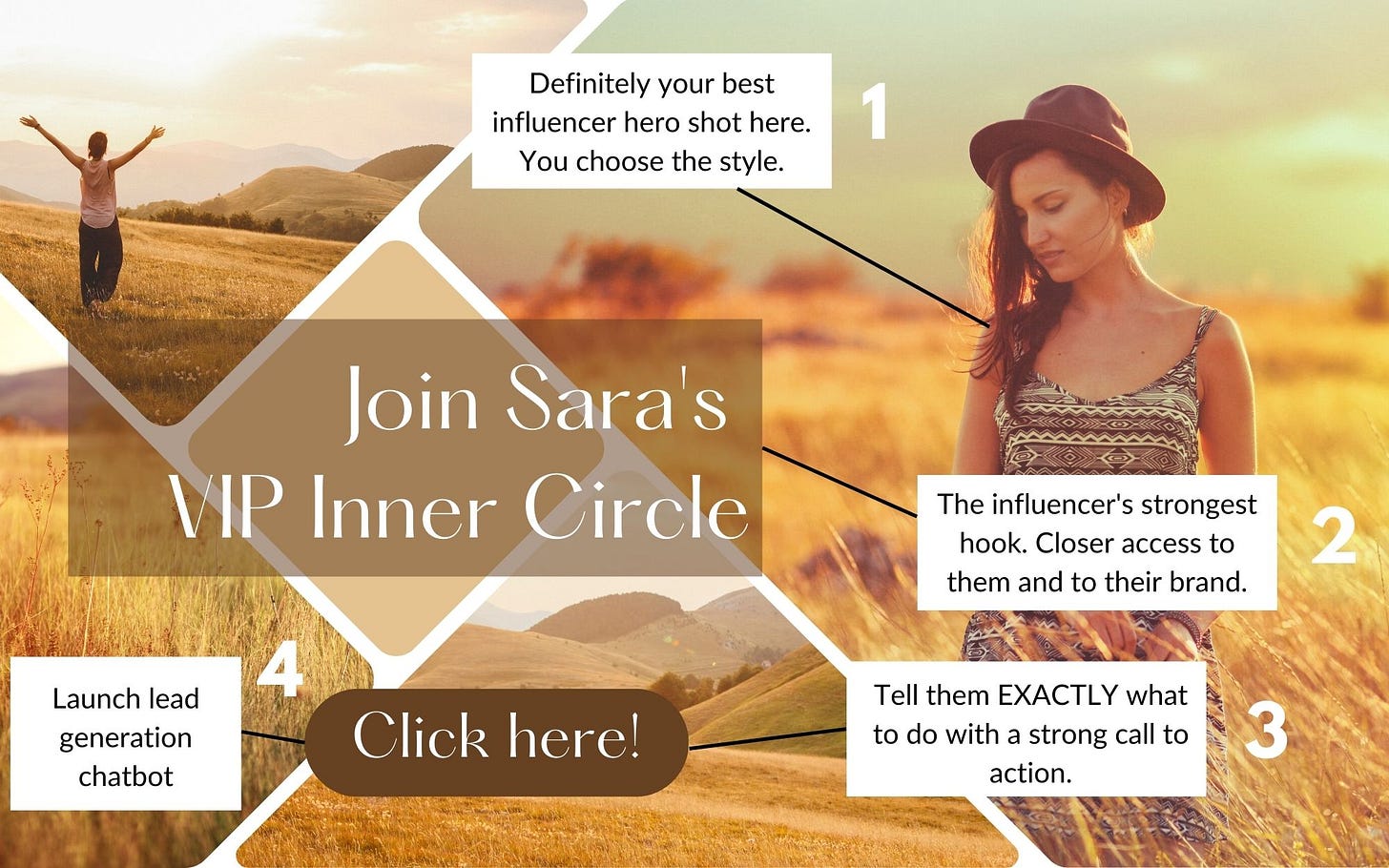How to Optimize Your Online Business For Lifetime Customers™
Introducing the Impact Generation Business Builder's Roadmap: Three phases to attract the perfect audience(s) and build long-term, happy, and repeat customers.
Introduction
Today I want to introduce you to the Impact Generation Business Builder’s Roadmap. It is our signature solution to help you optimize your online business for Lifetime Customers™.
This roadmap incorporates a different way of marketing which we covered in our manifesto and culture wall posts. This means being intentional about how we cultivate an audience. It also means that we place service and impact at the forefront of our marketing strategy.
As you reflect on our roadmap, it’s important to keep this approach to marketing in mind.
In this issue, I will summarize the elements of our business roadmap. In subsequent issues, I’ll dive deeper into each one including the mechanics.
Overview of Our Business Builder’s Roadmap
The following graph represents our way of building an online business of impact AROUND your craft as a sovereign creator.
The goal is to produce Lifetime Customers.
There are three phases which build upon each other:
Phase 1 is about gaining clarity on your audiences, and the products / services they most need.
Phase 2 is about connecting with your audiences in the most effective way possible. This is the stage where we configure your subscriber system.
Phase 3 is all about converting a portion of your subscribers into happy and repeat customers, or what we call Lifetime Customers.
Let’s dive a little deeper into each phase and the steps you’ll need to complete them.
Phase 1 - Clarity - You Must Get Clear on Your Business Fundamentals
Phase 1 is all about research in order to get clarity on your business fundamentals.
Research is not sexy, but it should be. It is 80% of the marketing game, and many entreprenuers skip this step to start learning tactics and strategies.
Big mistake.
Research is like mining for gold.
Most of the ideas and insights for your online business will come from your research. In addition, research will provide the language and emotion for your copy.
So, learn to embrace this phase. If you put in the work, you will reap big rewards.
Step 1 - Know your audience(s)
Step 1 in our roadmap is to know your audiences intimately.
Don’t aim for broad appeal here. You will get lost in a sea of bland. It’s the difference between shopping at Walmart for commodities and Clove and Twine for unique corporate gifts.
Within the Impact Generation, our primary audience consists of sovereign creators who want to monetize their craft AND make an impact. That description alone creates an emotional pull for the right kind of entrepreneur.
That’s what you want. To draw the right people into your world.
The mechanics of research are beyond the scope of this article. However, here’s a sample of what we’d like to know about the people in our audiences.
Basic demographics
Biggest problems, pains, frustrations, fears, goals, desires and aspirations
Books and publications they read, and experts they follow
Groups, forums and places where they congregate online
Products they buy to solve their problems or reach their goals
Top searches in Google and YouTube for the problems they are trying to solve
Step 2 - Identify your expert solutions
The second step of our roadmap is to use your craft or expertise to solve the biggest problems for your audiences. This process begins by creating a rough outline of your signature solution.
This generic roadmap will serve to illustrate:
IMPORTANT: If your solution requires only five steps, then go with that. Don’t get too hung up on our generic blueprint if it does not work for you.
Here are some important questions to consider:
What is the biggest problem / goal for your audiences?
What is the transformation you provide to solve that problem via your craft or expertise?
What are the three major phases to consider in solving this problem? (Think setup, build, and grow.)
What are the outcomes of those three phases?
What are the three major problems that you solve in each stage? These are the steps of your roadmap.
What is the unique mechanism that you use in your signature solution?
You can see that our roadmap answers these questions directly or indirectly.
NOTE: The exercise above will provide you with ten expert solutions: a big transformation plus nine smaller solutions in the form of the steps for your roadmap.
Step 3 - Create your best offer
An offer is a combination of your product / service and how it is packaged for a promotion. For example, a watercolor course can be part of multiple offers based on different audiences, mediums, deliverables, and even price.
There is one thing worth mentioning at this point.
Traditional marketing puts the offer up front, even if it means asking total strangers to make a purchase. Though conversions are abysmal, it makes financial sense since smart marketers can recoup their ad costs through later sales.
We prefer to showcase our offers AFTER we have established a relationship with our subscribers (Phase 3 of our roadmap). Thus we create the offer as part of our business fundamentals, but we will use it later.
NOTE: This does not mean you cannot make offers to cold traffic. This is actually one way to generate subscribers. But even here, the marketing philosophy of the Impact Generation would apply.
We suggest a workshop as your best offer
To create your best offer, this is our suggestion.
Take the most compelling step in your signature solution and turn that into a live Zoom workshop of 1.5 hours (see matrix below).
The reason this is a great offer is because of its high perceived value. But there are many benefits:
A high value means a higher price relative to the time you invest.
You will gain valuable marketing insights in a live environment.
A workshop is relatively easy to create: no complicated funnels, videos or materials to produce.
Phase 2 – Connection - Your Lead Generation Strategy
The purpose of the connection phase is to generate a list of engaged subscribers.
Your list is the most valuable asset your business can own. It is an asset you control, away from the chaos and distraction of social media. Finally, your Lifetime Customers will come from this group.
I should mention that we use an automated conversation (a chatbot) as the mechanism to collect an e-mail from our visitors. There are two major reasons for this:
One-to-one connection - You are starting a dynamic conversation with your peeps which is an incredible privilege. A passive landing page is no match for a real-time conversation.
There is a 60-75% opt-in rate with a chatbot conversation. You are lucky to get 15% on your static landing page.
I have written a blog post detailing nine reasons why chatbots beat landing pages for lead generation. But those reasons are secondary to the ones above.
Step 4 - Create your conversation magnet
In this step, our goal is to create an incentive for your audience members to become subscribers. This means creating a “lead magnet” or a “conversation magnet” in our case given our preference for chatbots.
The simplest way to create a conversation magnet is to take the most compelling step of your signature solution and create a template, checklist, cheat sheet, infographic, or framework for completing that step (or a portion of that step).
=====
Here’s an example our VIP Strategy roadmap. Step 4 is about optimizing all banners (website, Facebook, IG, etc.)
Here is a sample conversation magnet: a template to optimize a Facebook banner. This short PDF would include the visual below and a brief explanation of each element.
Step 5 - Your lead generation chatbot
Step 5 of our roadmap is to create your lead generation chatbot. Here is an example using our VIP Strategy:
A few observations:
This lead generation chatbot is the culmination of the work you have done up to this point. In other words, your research has given you a pinpoint and compelling conversation magnet. This means there should be little friction in generating a subscriber.
The structure of the lead generation bot is fairly static: confirm interest, ask for the e-mail, acknowledge, send to the appropriate next step (purchase, blog post, etc.)
Do not let the tech stand in the way of building a list of subscribers in the most effective way. Push through or call for help. It is the difference between a 15% and a 60% opt-in rate.
Step 6 - Your content strategy
There are two aspects to your content strategy:
Your signature content, which is a series of pillar articles that describe your philosophy, your signature solution, and its components.
Your seeding content which is a series of derivative pieces from your signature content. These plant seeds in your audience’s mind and draw them toward your world.
We’ll tackle each one in succession.
Your signature content
The Internet is now filled with millions of entrepreneurs creating an untold amount of content. A good amount of it is superficial and rehashed.
How are you ever going to break through?
The answer is to create signature content.
Your signature content is your philosophical approach to your craft COMBINED with a download of your expertise. It is a powerful and strategic mix.
Here’s the breakdown:
Article #1 - Your manifesto - Where you share your philosophy / vision for your business, cause, or movement. This helps draw the right people to your brand.
Article #2 - Your culture wall - Where you tell us the underlying values, principles, and philosophy that guide your endeavor.
Articles #3 - #12 - One article to describe your signature solution, and then a series of articles to break down each step.
Finally, don’t worry that you are giving away the farm. There will always be a certain percentage of your audience that will want to consume your content in another way or who want more access to you.
This is where the Product Matrix kicks in to help you increase your offers and build up your monetization channels.
Your seeding content
Your seeding content is a series of derivative parts of your signature content. This means any signature article can be turned into 100s of repackaged text, image, audio, and video content pieces.
For example, on my website, I have started to repurpose our manifesto and culture wall newsletters into a series of blog posts:
You can also create short social media posts / images to share the most compelling aspects of your signature content.
This image is from our culture wall newsletter. It talks about being very careful in how you build an audience.
Phase 3 - Conversion - Creating Lifetime Customers
This is the final phase of transforming your business. It is where we nurture your best subscribers into becoming Lifetime Customers.
The key here is having a sound e-mail strategy (follow-up and broadcast). This allows you to build relationships with your subscribers and to showcase new or existing products.
Step 7 - Follow-Up e-mails
Follow-up emails (also known as an autoresponder series) are sent out automatically AFTER someone becomes a subscriber. The number and frequency will vary depending on how someone came to be on your list:
Conversation / lead magnet (from Step 4)
If your subscribers came through a conversation magnet, your sequence will REINFORCE the important principles in the piece.
Here (as much as it pains me to say), you must pretend that your audience DID NOT consume what they received. Thus, your sequence will review all of the pertinent highlights of the conversation magnet.
For example, assume your piece highlighted three principles for finding peace among a chaotic day. This means you would cue up six e-mails over ten days to review each principle twice (in different ways).
The VIP Strategy
If you are using the VIP Strategy, we suggest an orientation sequence of 3-5 e-mails over seven days. The idea is to orient your VIP Group about your brand, values, history, and what they can expect for being a VIP.
NOTE: If the amount of e-mails and frequency seem excessive it is because:
You have had a bad experience with e-mail marketers spamming you
You do not know how to structure a compelling e-mail that your peeps look forward to reading
So two things.
Don’t use your experience as the benchmark. And, rest assured. You are going to master e-mails after completing Steps 7 and 8 of our business builder’s roadmap.
Step 8 - Your broadcast strategy
After someone has become a subscriber, your goal is to maintain regular contact via e-mail.
Regular contact means at least ONCE per week, and this should not feel like a burden. It is how you nurture subscribers into becoming customers, as well as Lifetime Customers.
The great Ben Settle sends out one e-mail per day (which is difficult for most entrepreneurs). Here at the Impact Generation, we are experimenting with one short e-mail and one meaty newsletter every week.
The content of your e-mail (whether standard or newsletter) is your expertise, sprinkled in with your personality and unique approach to the market.
Structure of your regular e-mails?
In every e-mail, try to entertain, educate, and elevate someone’s thinking:
Entertain - Entertain does not mean you have to become a comedian. Starting with a story, anecdote, compelling testimony or curious fact are solid ways to grab and keep someone’s attention.
Educate - Educate means providing folks with more of your craft, expertise, and solutions. This doesn’t mean you write a thesis on your subject. A golden nugget of information is more than sufficient for e-mail.
Elevate - Elevate is where you shift someone’s paradigm and create a-ha moments. You want your subscribers to think differently about themselves, the world, and your solutions. This is where the work you do for your manifesto and culture wall pay off (Step 6).
Always connect to an offer
Finally, we should mention that every e-mail you send should connect to an offer. Several prominent marketers suggest a ratio of three to one, value to offer e-mails.
Nonsense.
Either your products / service make an impact or they do not. And if they do, why would you hide them from the people who most need your solutions?
Three things to keep in mind in this respect:
Again, don’t use your negative experience with e-mail marketers as the benchmark. You are different remember? You are part of the Impact Generation.
Stop thinking in terms of sales. Instead, think impact and service, and you won’t have to “sell” ever again.
When you entertain, educate, and elevate someone’s thinking, promoting your offers will feel natural.
Step 9 - Diversify your offers
The final step of our roadmap is to increase the number of offers to serve your audiences and subscribers.
The graphic above demonstrates the variety of products you can create. They are arranged:
From the lowest to highest perceived value, price, and profit (with e-commerce being a wild card).
From the least to the most complex to produce (with the exception of a Zoom workshop and an e-commerce store).
The Product Matrix represents an ascension model
The Product Matrix also highlights an important marketing concept: the ascension model.
The idea is that many future Lifetime Customers will enter your eco-system via a low-ticket product such as an e-book, audio course, or video course. These products are more accessible, and will give your peeps a taste of your brand, teaching style and solutions to their problems.
Afterward, the ascension model kicks in based on human nature and how the market works:
A certain percentage of customers will want more access to you. This is where live workshops and retreats work well.
A smaller percentage of customers will want you to personally mentor them through the transformation they seek.
An even smaller percentage of customers will want to hire you to complete everything for them.
And there you have it, the Impact Generation Business Builder’s Roadmap. While there are many moving pieces (after all, you are building a real business), our roadmap can shortcut the process.
Most importantly, these are the phases to follow if you want to optimize your business for Lifetime Customers.
Here’s to your success.
Gustavo
NOTE: This article contains affiliate links to different resources. We receive a commission for anything you purchase through these links.

















